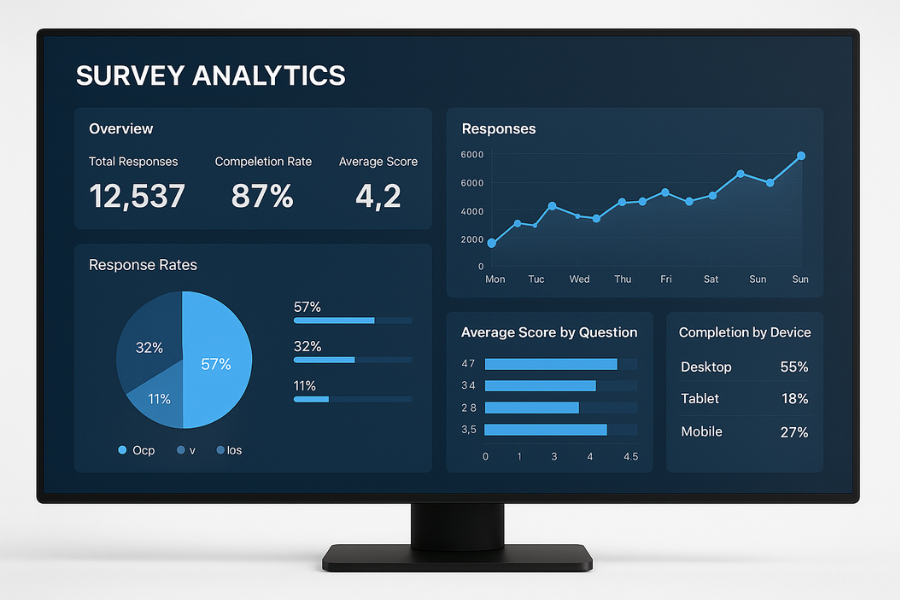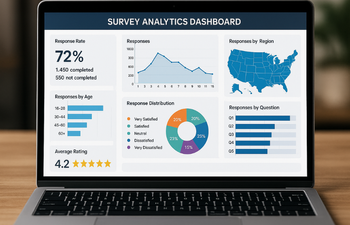Real-Time Survey Results: Why Instant Feedback Matters for Businesses
Explore why real-time survey results are crucial for fast-moving businesses seeking instant feedback and agile decision-making.

Introduction
In today’s lightning-paced digital economy, timing is everything. For businesses navigating hyper-competitive landscapes, waiting days or even hours for customer feedback can mean lost revenue, missed trends, or reputational damage. That's where real-time survey results make their grand entrance, equipping teams with the insights they need, exactly when they need them. But why does instant feedback matter so much in fast-moving business environments? And how can companies fully leverage this capability?
Let’s explore how the power of immediate response is reshaping the way businesses make decisions, serve customers, and outpace competitors.
The Evolution of Feedback Collection
Before real-time technology, companies relied heavily on retrospective data. Surveys were mailed or emailed, results were tallied over weeks, and by the time insights were shared, market dynamics had already shifted. This lag rendered many strategies ineffective or outdated.
Fast-forward to now: cloud platforms, automation, and mobile devices allow companies to gather, analyze, and act on survey data within minutes. It’s a revolution in agility and responsiveness.
What Are Real-Time Survey Results?
Real-time survey results refer to data collected and made available instantly as respondents submit their feedback. This immediate insight eliminates the traditional lag time between data collection and action.
Unlike traditional surveys that require manual intervention, real-time systems leverage:
- Live dashboards with instant data visualization
- Automated analytics and sentiment detection
- API integrations that sync feedback across platforms
Benefits of Real-Time Survey Results in Fast-Moving Businesses
Speed to Action
Immediate insights allow businesses to correct course instantly. For instance, if a product rollout isn’t being received well, the marketing team can adjust messaging on the fly.
Enhanced Customer Experience
When customers feel heard in real time, their loyalty deepens. Real-time feedback lets companies acknowledge issues and respond, sometimes within minutes.
Reduced Operational Lag
Operations teams use real-time results to spot inefficiencies, address bottlenecks, and optimize processes in the moment, not after the fact.
Better Employee Engagement
Real-time pulse surveys help gauge morale and engagement levels among employees, allowing HR to intervene early and proactively.
Accurate, Time-Stamped Context
Feedback that is received instantly carries greater context. You know exactly when, where, and under what conditions it was given, which enhances accuracy.
Real-Time Survey Results Across Business Functions
Customer Support
Real-time CSAT (Customer Satisfaction) scores allow teams to follow up with dissatisfied customers right away, improving retention and resolution rates.
Product Development
Instant input during beta testing phases helps developers address usability issues or bugs rapidly, shortening development cycles.
Marketing Campaigns
Teams can A/B test in real time and use survey data to understand what's resonating, what isn't, and where adjustments are needed.
Employee Feedback
Real-time engagement surveys can prevent resignations, identify burnout, and empower managers to take swift, constructive action.
Tools That Enable Real-Time Survey Results
Key Metrics To Track in Real-Time Surveys
Response Rate
High response rates indicate good engagement and reflect how effective your survey delivery method is.
Net Promoter Score (NPS)
This quick gauge of customer loyalty can be tracked live to inform product and service tweaks.
Sentiment Analysis
AI tools can analyze tone and emotion in open-ended responses, giving deeper real-time insights.
Completion Time
Shorter survey completion times can indicate better user experience or engagement.
Integrating Real-Time Survey Results into Business Workflows
To maximize value, survey results should feed directly into CRM, project management, or marketing platforms. That way, the insights translate into action immediately.
Examples include:
- Triggering customer service tickets for low CSAT responses
- Sending marketing follow-ups based on NPS categories
- Updating dashboards for team meetings or leadership updates
Challenges of Real-Time Survey Systems
Data Overload
Too much feedback can become noise. Smart filtering and AI-based prioritization help combat this.
Bias from Early Respondents
Initial feedback may not represent the whole group. Time-sensitive weighting may help offset this.
Cost and Integration
High-end real-time platforms can be pricey. Integration with legacy systems is also complex.
Privacy and Compliance
Instant data handling must still respect user consent, GDPR, and other data protection laws.
Case Studies: Real-Time Feedback in Action
Starbucks
Uses mobile app surveys to gather real-time feedback and immediately deploy operational fixes or reward offers based on customer sentiment.
Airbnb
Hosts and guests receive real-time surveys post-stay, allowing for faster conflict resolution and better experience tailoring.
Google uses real-time surveys internally to drive employee engagement and continuously shape team policies and culture.
For more on leveraging surveys for employee engagement, see our post on How to Run Employee Engagement Surveys That Actually Work.
Best Practices for Implementing Real-Time Survey Feedback
Keep It Short and Simple
Brevity encourages participation. Aim for under five questions unless absolutely necessary.
Choose the Right Time
Context matters. Catch users right after a transaction or experience for more relevant responses.
Automate but Don’t Dehumanize
Automated responses should still feel personal. Use names, reference the experience, and offer tangible next steps.
Provide Visible Impact
Close the feedback loop. Let respondents know how their input is used, it encourages future participation.
If you're interested in improving survey response rates, check out our article on How to Boost Your Survey Response Rate: 7 Proven Tips.
Real-Time Survey Results for Agile Businesses
Agility isn’t just about speed, it’s about smart speed. Businesses that harness real-time feedback develop a sixth sense for change, enabling them to adapt, pivot, and flourish where others lag behind.
Real-Time Survey Results and Future Trends
AI-Powered Insights
Natural language processing and AI will further improve how we interpret open-ended responses in real time.
Predictive Feedback Models
Soon, real-time feedback will help not just understand the present, but predict future behaviors and needs.
Multichannel Feedback Ecosystems
From SMS to voice to wearable tech, feedback channels will diversify and become even more integrated.
Conclusion
In an era where attention spans are short and the market waits for no one, real-time survey results are no longer a luxury, they’re a necessity. For businesses aiming to stay ahead, respond swiftly, and create truly customer-centric operations, instant feedback provides both the lens and the lever for progress. From customer support to product design, from internal morale to marketing agility, this data-rich, insight-driven strategy is what separates the disruptors from the disrupted.
Frequently Asked Questions
Find answers to the most common questions about this topic
Real-time feedback enables businesses to make quick decisions, respond to customer needs promptly, and maintain a competitive edge in dynamic markets.
Tools like Typeform, Google Forms with integrations, Qualtrics, and real-time dashboards enable fast feedback collection and visualization.
It allows businesses to immediately resolve issues, adapt offerings, and personalize interactions, which enhances overall customer satisfaction.
No, it’s equally valuable in employee engagement, product development, training, and internal operations.
Delayed reactions, missed opportunities, customer churn, and poor decision-making due to outdated data are common risks.
Yes, automation through CRM, email triggers, chatbots, and web apps can streamline the feedback collection and analysis process.









